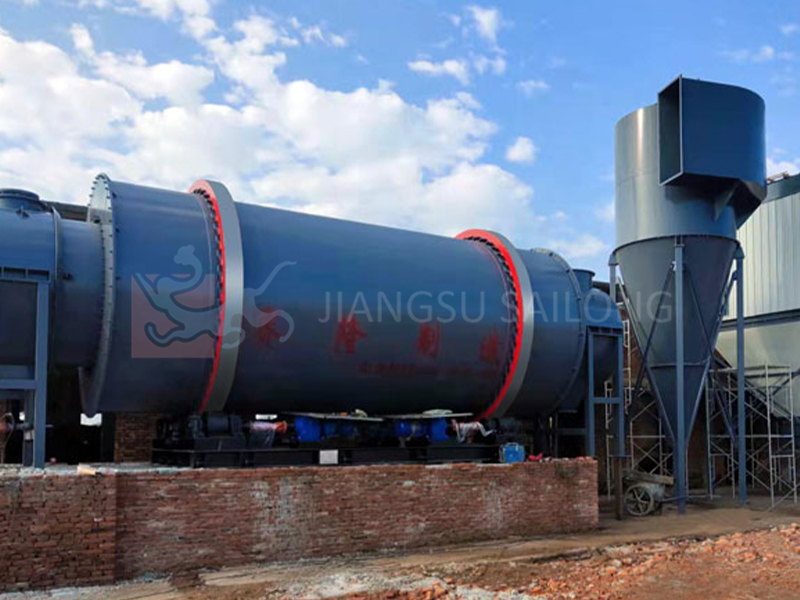Rotary Dryers are critical equipment in mining operations, designed to efficiently remove moisture from minerals, ores, and aggregates. Their robust design and adaptability make them indispensable for processing materials like iron ore, copper concentrate, bauxite, and sand. Below is a detailed exploration of their key features, technical specifications, and applications in the mining sector.
1. Structural Robustness and Material Durability
Mining environments are harsh, characterized by abrasive materials, high temperatures, and continuous operation. Rotary dryers for mining are engineered to withstand these conditions:
Heavy-Duty Construction: The dryer shell is typically fabricated from carbon steel or stainless steel, with thicknesses ranging from 10mm to 25mm, depending on the application. This ensures resistance to deformation under thermal stress and mechanical loads.
Abrasion-Resistant Liners: Internal lifters and flights are often coated with abrasion-resistant materials (e.g., ceramic tiles, AR steel) to prevent wear from coarse ore particles.
Corrosion Protection: For operations involving acidic or alkaline materials, the dryer may feature acid-resistant coatings or dual-layer stainless steel cladding.
2. High-Temperature Resistance
Mining dryers frequently operate at elevated temperatures to achieve rapid moisture evaporation:
Temperature Range: Operating temperatures typically span 200°C to 800°C, with some specialized units exceeding 1,000°C for calcination processes.
Thermal Insulation: Advanced insulation materials (e.g., ceramic fiber blankets) reduce heat loss and maintain energy efficiency.
Fuel Flexibility: Supported by burners compatible with natural gas, fuel oil, coal, or biomass, allowing adaptation to local fuel availability and cost structures.

3. Efficient Heat Transfer Mechanisms
Optimal heat transfer is critical for energy efficiency and throughput. Key design elements include:
Flight Design: Helical or modular flights lift and cascade material, maximizing surface area exposure to hot gases. For sticky materials, self-cleaning flights prevent buildup.
Counter-Current Flow: Hot air flows in the opposite direction to the material, enhancing heat recovery and moisture evaporation efficiency.
Preheating Systems: Integrated preheating chambers utilize waste heat from the exhaust stream to reduce energy consumption.
4. Dust Control and Emission Compliance
Mining dryers must comply with stringent environmental regulations:
Cyclone Separators: High-efficiency cyclones capture particulate matter (PM) from exhaust gases, achieving emission levels below 50 mg/Nm³.
Baghouse Filters: For ultra-fine particles, pulse-jet baghouses provide filtration efficiencies exceeding 99.9%, ensuring compliance with standards like the U.S. EPA’s MACT rules.
Wet SCRubbers: In areas with strict emissions limits, wet scrubbers neutralize acidic gases and capture PM.
5. Process Automation and Control
Modern rotary dryers incorporate advanced control systems for precision operation:
PLC/SCADA Integration: Real-time monitoring of temperature, airflow, and material moisture content enables automated adjustments to maintain product quality.
Variable Frequency Drives (VFDs): Adjustable-speed drives optimize drum rotation (typically 1–10 RPM) and airflow rates, reducing energy waste during low-demand periods.
Moisture Sensors: In-line NIR or microwave sensors provide instantaneous moisture readings, allowing dynamic process adjustments.
6. Capacity and Scalability
Mining dryers are designed to handle large volumes of material:
Throughput: Capacities range from 10 tons/hour (tph) for small-scale operations to over 1,000 tph for industrial-grade units.
Modular Design: Scalable configurations allow expansion as mining operations grow, with options for parallel or series dryer arrangements.
Large Drum Dimensions: Diameters often exceed 4 meters, with lengths up to 40 meters to accommodate high residence times.
7. Application-Specific Adaptations
Different mining applications require tailored designs:
Iron Ore Pelletizing: Dryers with preheating zones and controlled atmosphere systems ensure uniform moisture removal for pellet durability.
Copper Concentrate: Inert gas-purged dryers prevent oxidation of sulfide ores.
Bauxite Processing: High-temperature units (800°C+) for calcination to improve alumina recovery.
Frac Sand Drying: Multi-stage dryers with cooling sections to meet API specifications for roundness and crush resistance.
8. Safety Features
Mining dryers prioritize operational safety:
Explosion Relief Panels: Vented panels prevent pressure buildup in combustible dust environments.
Fire Suppression Systems: Automated deluge systems or CO₂ extinguishers mitigate fire risks.
Gas Leak Detection: For fuel-fired units, infrared sensors monitor for combustible gas leaks.
9. Maintenance and Longevity
Reducing downtime is critical for mining profitability:
Quick-Access Hatches: Removable panels allow rapid inspection of flights and liners.
Wear Monitoring: Laser scanning or ultrasonic testing detects liner thickness loss, enabling predictive maintenance.
Spare Parts Availability: Manufacturers often stock critical components (e.g., tires, gears) to minimize repair delays.
10. Cost Efficiency
Balancing capital expenditure with operational costs is key:
Energy Recovery: Heat exchangers recapture waste heat for preheating combustion air or feed material.
Low Maintenance Design: Self-aligning roller supports and corrosion-resistant materials reduce lifecycle costs.
Fuel Efficiency: Optimized burner designs and insulation minimize fuel consumption per ton of material dried.
Conclusion
Rotary dryers in mining are engineered for durability, efficiency, and adaptability. Their ability to handle abrasive materials, operate at high temperatures, and integrate with downstream processes (e.g., pelletizing, smelting) makes them indispensable. By prioritizing features like robust construction, advanced automation, and emission control, modern dryers enhance productivity while meeting environmental and safety standards. For mining operators, selecting a dryer tailored to specific ore characteristics and operational goals is critical to maximizing ROI and ensuring sustainable production.
This website uses cookies to ensure you get the best experience on our website.
Comment
(0)